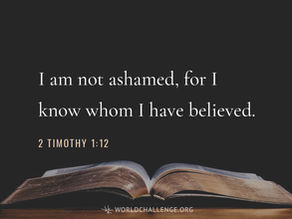John 20:26–31 - A Book with an Eternal Implications
- Joe Steenholdt
- Feb 19, 2024
- 4 min read
The Bible doesn’t tell us everything, but it tells us enough for salvation.
John 20:26–31 (NIV)
CONTEXT: After Jesus rose from the dead, He appeared to His disciples, but Thomas wasn't with them at the time. When Thomas came back, he famously stated that he wouldn't believe until he touched Jesus' wounds with his own finger.
26 A week later his disciples were in the house again, and Thomas was with them. Though the doors were locked, Jesus came and stood among them and said, “Peace be with you!” 27 Then he said to Thomas, “Put your finger here; see my hands. Reach out your hand and put it into my side. Stop doubting and believe.”
28 Thomas said to him, “My Lord and my God!”
29 Then Jesus told him, “Because you have seen me, you have believed; blessed are those who have not seen and yet have believed.”
30 Jesus performed many other signs in the presence of his disciples, which are not recorded in this book. 31 But these are written that you may believe that Jesus is the Messiah, the Son of God, and that by believing you may have life in his name.
Listen to passage & devotional:
Belgic Confession of Faith, Article 7: The Sufficiency of Scripture
We believe
that this Holy Scripture contains
the will of God completely
and that everything one must believe
to be saved
is sufficiently taught in it.
For since the entire manner of service
which God requires of us
is described in it at great length,
no one—
even an apostle
or an angel from heaven,
as Paul says—
ought to teach other than
what the Holy Scriptures have
already taught us.
For since it is forbidden
to add to or subtract from the Word of God,
this plainly demonstrates
that the teaching is perfect
and complete in all respects.
Therefore we must not consider human writings—
no matter how holy their authors may have been—
equal to the divine writings;
nor may we put custom,
nor the majority,
nor age,
nor the passage of time or persons,
nor councils, decrees, or official decisions
above the truth of God,
for truth is above everything else.
For all human beings are liars by nature
and more vain than vanity itself.
Therefore we reject with all our hearts
everything that does not agree
with this infallible rule,
as we are taught to do by the apostles
when they say,
“Test the spirits
to see if they are of God,”
and also,
“If anyone comes to you
and does not bring this teaching,
do not receive him
into your house.”
Summary
John 20 recounts Jesus’ resurrection and post-resurrection appearances, which reaches a crescendo when Thomas is finally able to see the resurrected Christ with his own eyes—the one who had been crucified and laid in a tomb—and proclaim his beautiful confession of faith, “My Lord and my God!” (John 20:28).
It is after this that John pauses to say, “this is why I wrote this book — so that you may believe and confess Jesus is Lord, just like this.” The purpose of the book of John is the same as all of the books in the Bible: so that “you may believe that Jesus is the Christ, the Son of God, and that by believing you may have life in his name” (20:31).
John includes many of the signs and teachings of Jesus throughout his account, but he only includes certain ones. The other three Gospel accounts include others that John does not, but even those do not include every last detail of Jesus’s earthly life and ministry.
Just like if you were to write a biography about your father, you would not include everything you know about him, but you'd focus on the crucial parts that can communicate an important theme or life lessons. It would not do your readers any good to fill chapter upon chapter with daily logs of his meals, clothing, and every muttering.
So, the gospel writers and all biblical authors were selective in the details included about Jesus. (John 21:25, “Now there are also many other things that Jesus did. Were every one of them to be written, I suppose that the world itself could not contain the books that would be written.”)
So, we should pay close attention to which details Scripture includes and why they are there!
Dig Deeper
There are probably many times when you wish you knew more than what the Bible includes. We will all have specific questions we look forward to inquiring about in heaven that are not revealed to us now. What was Jesus like as a boy and young man? The Bible includes very little about his younger years or what projects he may have helped his carpenter dad with.
Even though thousands of paintings and many shows and movies depict Jesus looking a certain way, there are no physical descriptions of him in Matthew, Mark, Luke, or John either. Yet, as fascinating as our curiosities may be, the essentials are provided. If certain information is not found in the Bible, it is not crucial for our salvation.
The most important thing is that you know what is contained in Scripture, and that it was written for you to know the will of God, which is most clearly seen through the sending of His Son, Jesus Christ—the promised Messiah who was born, lived, died, and rose again to save His people from their sins and grant eternal life in God’s presence.
A couple of weeks ago, we considered the various genres in the Bible and how God communicates His truth in many ways to help us understand His redemptive plan through Christ. The Bible as a whole shows us our need for this salvation, how God accomplished it, and how we live in light of this great work of salvation.
When it comes to knowing what we need to learn about God’s saving acts through Christ, we have everything we need for eternal life included from Genesis to Revelation.
Will you receive and trust this testimony? God graciously offers you eternal life through His Son, who “came that they may have life and have it abundantly” (John 10:10b).
ACKNOWLEDGE WHO GOD IS: "My Lord and My God!"
ALIGN YOUR LIFE WITH GOD'S WILL: Pray that you will have the eyes of faith and know the eternal life that comes through Jesus Christ;
ASK GOD FOR WHAT YOU NEED:
Read the New Testament in a year! Today: Acts 20




















Comments